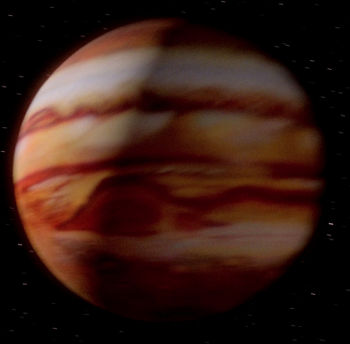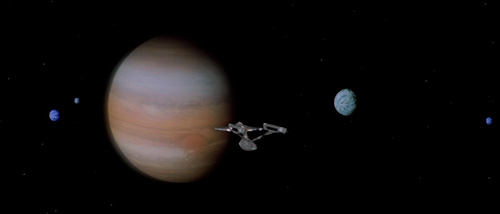Difference between revisions of "Jupiter (FASA)"
From Trekipedia
(Redirected page to Jupiter) Tag: New redirect |
(Removed redirect to Jupiter) Tag: Removed redirect |
||
| Line 1: | Line 1: | ||
| − | # | + | {{MyriadJupiter}} |
| + | {{ImageInfoBox2|name=Jupiter|file=jupiter-tng-101-102.jpg|caption=Jupiter ([[Star Trek: The Next Generation|TNG]] [[Encounter at Farpoint (Episode)|101-102]])}} | ||
| + | {{TableRow|title=Coordinates|data=23.9, 61.8, 0.0<ref name="Maps"/>}} | ||
| + | {{TableRow|title=Affiliation|data=[[United Federation of Planets]]<ref name="TOS00"/>}} | ||
| + | {{TableRow|title=Satellites|data=18 moons,<ref name="WoF"/> including [[#Galilean_Moons|Galilean moons]]: Io (Sol Va), [[Europa (FASA)|Europa]] (Sol Vb), Ganymede (Sol Vc), Callisto (Sol Vd)}} | ||
| + | {{TableRow|title=Advertising|data={{AmazonLink2}} {{AmazonLinkFASA2011}} }} | ||
| + | |}</div> | ||
| + | A [[Planetary Classes (FASA)#Class A|Class A planet]],<ref name="WoF"/> Jupiter was the largest planet in the [[Sol system]], and orbits fifth from its parent star.<ref name="TOS37"/> Although Jupiter, being a gas giant, was uninhabitable by humanoid life, its four largest moons, known as the Galilean moons, were colonized by [[Humans (FASA)|Humans]].<ref name="FASA2011"/> | ||
| + | |||
| + | {{ImageBox2|float=left|file=jupiter-st01.jpg|caption=Jupiter and moons ([[Star Trek: The Motion Picture (Film)|ST01]])}} | ||
| + | Jupiter roils with constant storms, the most famous of which, the Great Red Spot, remains one of the planet's most popular sightseeing destinations. The Great Red Spot was <!--first observed through a telescope in the 17th century by [[Galilei, Galileo|Galileo Galilei]]; it was -->still going strong well into the 23rd century.<ref name="ST01"/> | ||
| + | |||
| + | {{References}} | ||
| + | <references> | ||
| + | <ref name="TOS00">{{RefTOS00}}</ref> | ||
| + | <ref name="ST01">{{RefST01}}</ref> | ||
| + | <ref name="FASA2011">{{RefFASA2011}}</ref> | ||
| + | </references> | ||
| + | [[Category:Library]] | ||
| + | [[Category:Astrometrics]] | ||
| + | [[Category:Planets]] | ||
| + | [[Category:Class A Planets]] | ||
| + | [[Category:Federation Planets]] | ||
| + | [[Category:TOS]] | ||
| + | [[Category:TAS]] | ||
| + | [[Category:TNG]] | ||
| + | [[Category:Film]] | ||
| + | [[Category:Books]] | ||
| + | [[Category:Games]] | ||
| + | [[Category:RPG]] | ||
| + | [[Category:FASA Timeline]] | ||
Revision as of 09:42, 23 April 2021
Myriad Universes: Jupiter
Jupiter
| Coordinates | 23.9, 61.8, 0.0[1] |
| Affiliation | United Federation of Planets[2] |
| Satellites | 18 moons,[3] including Galilean moons: Io (Sol Va), Europa (Sol Vb), Ganymede (Sol Vc), Callisto (Sol Vd) |
| Advertising |
A Class A planet,[3] Jupiter was the largest planet in the Sol system, and orbits fifth from its parent star.[4] Although Jupiter, being a gas giant, was uninhabitable by humanoid life, its four largest moons, known as the Galilean moons, were colonized by Humans.[5]
Jupiter and moons (ST01)
Jupiter roils with constant storms, the most famous of which, the Great Red Spot, remains one of the planet's most popular sightseeing destinations. The Great Red Spot was still going strong well into the 23rd century.[6]
Notes and References
- ↑ Cite error: Invalid
<ref>tag; no text was provided for refs namedMaps - ↑ Template:RefTOS00
- ↑ 3.0 3.1 Cite error: Invalid
<ref>tag; no text was provided for refs namedWoF - ↑ Cite error: Invalid
<ref>tag; no text was provided for refs namedTOS37 - ↑ Menke, Bernard Edward and Rick David Stuart (Authors). The Federation. Star Trek: The Role Playing Game. Book 2011. Cover art by David R. Deitrick. Illustrations by Todd F. Marsh, John C. Tylk, Bob Eggleton, Daniel E. Carroll, and Jay Harris. FASA Corporation. 1986.
- ↑ Roddenberry, Gene (Producer). Star Trek: The Motion Picture. Directed by Robert Wise. Story by Alan Dean Foster. Screenplay by Harold Livingston. Paramount Pictures. 7 December 1979.



